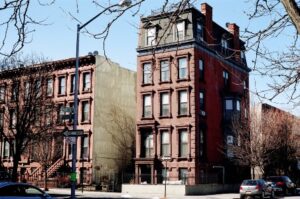Chicago's best property management company, providing tenant screening, rent collection, property marketing, and more at reasonable cost.
Park Ridge Property Management at its best!
Three Pentacles is a trusted property management company in Park Ridge, IL. Managing residential properties, commercial properties, HOA associations, and short-term vacation properties, Three Pentacles works hard to provide you with the customized property management service that works for you.
We Manage All Types of Properties in Park Ridge
About Park Ridge
Incorporated in 1873, Park Ridge is a city in Cook County, Illinois, United States, and a Chicago suburb. The population was 37,480 at the 2010 census. It is located 15 miles northwest of downtown Chicago in Maine Township. Zip code: 60068. The Pottawatomie Indians found our land fertile and rich in natural resources. French explorers knew it as a convenient portage between the Des Plaines and Chicago rivers. Illinois had been a state since 1818 when the first settlers from New England and New York came to this area in the early 1830s. Captain Mancel Talcott built Park Ridge’s first house in the area of Touhy and Dee; his son built a house at Touhy and Northwest Highway in 1840.

A brickyard was started in the vicinity of Meacham, Elm and Grand Avenue in 1853 by George Penny, giving the little village its first name, Pennyville. At Penny’s request, the name was changed to Brickton in 1858. Expansion came to Brickton with the coming of the railroad, increased immigration from the East and Europe, and as an aftermath of the great Chicago fire in 1871. The agrarian society was changed by the Industrial Revolution, and by the time of incorporation in 1873, Park Ridge had been transformed from an agricultural community to an affluent business town. The new village had no public sewer or water facilities. Water was supplied by private wells and from a well at the intersection of Touhy and Northwest Highway. It was not until 1922 that the city began to purchase water from the City of Chicago. An eight-room grammar school was built in 1893 on the site of the present library and a high school district was formed in 1902, the year telephone service began. A volunteer fire department was started in 1893 and the first full-time police officer was appointed in 1898. Andrew Carnegie donated $7,500 to fund a library in 1910.
Citizens impatient to replace unpaved streets and plank sidewalks and expand the inadequate sewer system formed a political group to push for improvements and change to a city form of government. An opposing group fought to keep the small town atmosphere, but the choice was made to incorporate Park Ridge as a city in 1910. Under the new form of government, a mayor and aldermen—elected from wards—governed rather than a president and trustees elected at-large. Truck farmers supplied Chicago with vegetables, flowers and spices. Park Ridge was advertised as “A Restoring Place of Health & Vigor, The Recreation Place of the Tired & Worn Out,” and became the first suburban stop on the North Western track. An artist’s colony made up of artisans, sculptors, printers and musicians was established. The park system was formed in 1914.
The 1920s saw another era of growth. The American Legion, Kiwanis and Lions Clubs were active; Bredemann, Moheisers Clothing Store, Scharringhausen’s Drug Store and George’s Men’s Store were established. (Only the Bredemann Auto Group, now on Dempster Street, is still in business) The Pickwick Theatre, “suburban Chicago’s Most Beautiful Theater,” was opened in 1928. In the 1930s the WPA (Works Progress Administration) brought men into Park Ridge to repair streets and a WPA mural was painted in the post office at 164 S Prospect, now the School District 64 administration offices. The mural, entitled “Indians Cede the Land,” by George Melville Smith, which had been stored by a Park Ridge citizen for 38 years, was returned to the Park Ridge Public Library in 2008. During the post World War II boom (1945-1975) the town experienced an almost complete build-up of homes, predominantly ranch-style houses. O’Hare became a commercial airport in 1956, the new library was dedicated in 1958, and Lutheran General Hospital opened in 1959. The exodus from Chicago in the 1960s and 70s, the construction of new expressways, and the growing number of jobs in the suburbs meant further expansion for the city.
The economic depression of the early 1980s put a damper on building, but by the late 1980s the economy had improved and expansion came in the 1990s as smaller, older houses were replaced with new home construction. In 1999, the process for creating the Uptown project began and from 2002-2009 the Residences & Shops of Uptown were developed consisting of retail commercial space and residential townhouses, row houses, lofts units and condominiums. A citizens’ referendum to reduce the size of the Park Ridge City Council from 14 aldermen, two from each of the city’s seven wards, to seven aldermen, one from each ward, was successfully passed in November 2006. The new seven-member council was elected for the first time in April 2007. The council later voted to stagger the terms of the aldermen, with four wards electing aldermen during one local election and the remaining three wards electing aldermen during the next local election.
A Village Is Born, “To the Honorable W R M Wallace, County Judge of Cook County Illinois: We the undersigned legal voters residing upon a tract of land known and described as (legal description follows) would respectfully represent that there are residing within said limits a population of not less than four hundred inhabitants…and the best interest of the inhabitants of said tract will be promoted by organizing as a Village under the name of Park Ridge under the provisions of an act of the General Assembly of the State of Illinois.” With that request of the fifth day of February A D 1873, to put the matter to a vote of the 405 inhabitants residing in the territory (based on a census taken by Robert W Meacham and Owen A Sweet), and by an election held on the 15th day of April 1873, and with the swearing in of new trustees on April 23rd 1873, and by the certification of that election on the 19th day of June 1873, the Village of Park Ridge was officially recognized.
The first trustees elected were George B Carpenter (66 votes), who was elected president by a vote of the trustees; Augustus Dickenson (67 votes); Joseph T Janes (67 votes); Loring D Tenant (65 votes); Charles Kobow (52 votes); and W Sanford Chittendon (32 votes). Samuel E Cummings was elected City Clerk with 61 votes. The first ordinances adopted by the Board of Trustees “for the government of the Village of Park Ridge,” were organized into 17 Articles, including Auctions, Births and Deaths, Dogs, Fees, Health, Licenses, Misdemeanors, Peddlers, Sale of Liquor, Shows, Sidewalks and Trees. The Village voted to become a city at an election held on May 24, 1910, in the baggage room of the Chicago and North-western Railroad station. Albert J Buchheit was elected the first mayor and presided at the first City Council meeting on July 7, 1910. The Council organized the city into three wards.
We understand the ins and outs of local real estate
Need Help? Inquire About Our Management Services Here
Are you maximizing your rental property’s potential?




